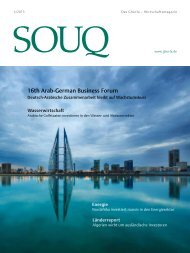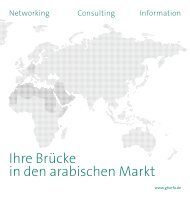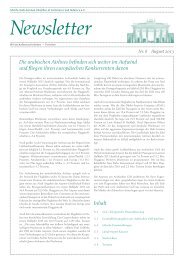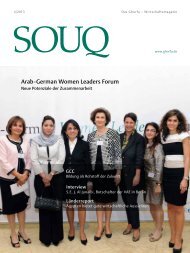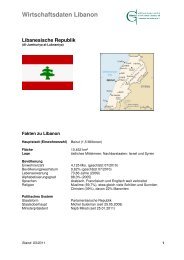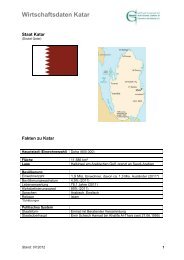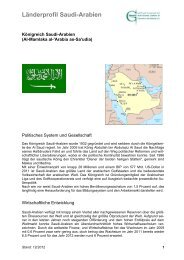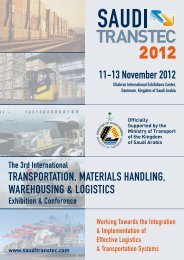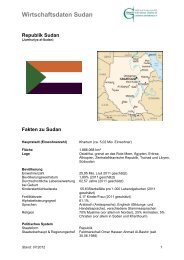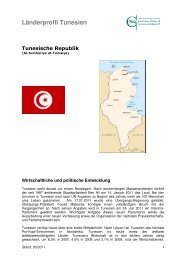Saudi-Arabien Wirtschaftshandbuch Saudi Arabia Business ... - Ghorfa
Saudi-Arabien Wirtschaftshandbuch Saudi Arabia Business ... - Ghorfa
Saudi-Arabien Wirtschaftshandbuch Saudi Arabia Business ... - Ghorfa
Erfolgreiche ePaper selbst erstellen
Machen Sie aus Ihren PDF Publikationen ein blätterbares Flipbook mit unserer einzigartigen Google optimierten e-Paper Software.
60<br />
Computernetze landesweit eingeführt. „Telework“ ist<br />
heute in vielen Bereichen, z.B. im Gesundheitswesen,<br />
den Medien und Verlagen, weit verbreitet. 2004 wurde<br />
das „e-government“-Programm eingeführt. Abgesehen<br />
von den Großunternehmen wie ARAMCO, SABIC und<br />
SAUDIA nutzt die Mehrzahl der Firmen e-commerce<br />
nur für wenige Operationen. Daher werden Anstrengungen<br />
unternommen, um die aktive Wahrnehmung<br />
der Internetmöglichkeiten innerhalb der Geschäftswelt<br />
zu fördern.<br />
Zwar ist die Zahl der Internetnutzer von 0,6 Millionen<br />
(2000) auf 4,7 Millionen (2007) beträchtlich angestiegen,<br />
gemessen an der Bevölkerung beträgt der Anteil<br />
der registrierten Internetteilnehmer aber nur 19,5%.<br />
Im weltweiten Vergleich ist dies noch immer ein niedriges<br />
Niveau der Internetnutzung. Dies hängt unter anderem<br />
mit den hohen Internetzugangskosten, der noch<br />
niedrigen Leistungsqualität und den noch ungenügend<br />
verbreiteten IT-Kenntnissen zusammen. Mit der fortschreitenden<br />
wirtschaftlichen Entwicklung ist aber ein<br />
steigender Internetbedarf zu erwarten. Der 8. Entwicklungsplan<br />
sieht daher die Schaffung von weiteren 2,4 bis<br />
3,4 Millionen Internet-Anschlüssen vor.<br />
–––––––––––––––––––––––––––––––<br />
telecommunIcAtIon<br />
And It-SectorS<br />
Telecommunications and information technology play an<br />
important role in the economic and social development<br />
of <strong>Saudi</strong> <strong>Arabia</strong>. Similar to other countries, the Kingdom<br />
has recognised how vital this sector is for increasing<br />
productivity, creating new jobs and achieving balanced<br />
regional development. It is estimated that the use of these<br />
technologies grew 9% every year in the period between<br />
2002 and 2005.<br />
Since the middle of the 1990s, the telecommunications<br />
sector has developed dynamically and undergone a radical<br />
change. The number of landline connections grew from<br />
2.7 million (1999) to 4.5 millions (2006). In the mobile<br />
telephone sector during the same period, registrations<br />
grew from 0.8 million to 19.7 million. Also a number of<br />
other services such as the Internet, prepaid card systems,<br />
mobile connections via satellite, ISDN-connections and<br />
ATM-services were introduced.<br />
The <strong>Saudi</strong> Telecom Company (STC) is the main supplier<br />
of landlines and other communication forms. In recent<br />
years, the STC was responsible for covering the continuously<br />
growing demand for landlines and mobile lines. In<br />
2002 the STC also introduced a prepaid system for the<br />
mobile network (also known as “SAWA”). There are 24<br />
licensed providers of Internet services.<br />
To further raise the efficiency of the communication systems,<br />
free competition elements were introduced. At the<br />
end of 2004, work began on liberalising the mobile telephone<br />
network by issuing a licence to a second mobile<br />
network provider. At the same time, step-by-step privatisation<br />
of the STC was commenced. In 2007 the landline<br />
telephone service market was opened to private investors.<br />
Also, a communication and information technology authority<br />
was created to regulate and monitor the sector.<br />
In recent years, concerted efforts have been made in <strong>Saudi</strong><br />
<strong>Arabia</strong> to create the underlying legal conditions for the<br />
broad use of communication and information technologies<br />
in business and social circles through to the development<br />
on an information society. This had an effect on e.g.<br />
the introduction of legal regulations to protect property<br />
rights, in particular with regard to the protection of software<br />
products and computer systems. Regulations were<br />
also drawn up to protect the communication networks<br />
from illegal access and theft. There are also plans to introduce<br />
services such as digital signatures and authentication<br />
certificates (attestations). Furthermore, the SAMA<br />
has issued regulations for Internet banking services.<br />
On the user side, many government offices, public and<br />
private companies have created their own homepages.<br />
Some government institutions are also trying to offer<br />
electronic services such as e.g. data exchange, the payment<br />
of fees, the issue of visas and dispensing of “smart<br />
cards”. Computers have been installed in hospitals across<br />
the country. “Telework” is now widespread in many areas<br />
such as e.g. the health sector, the media industry and publishing<br />
companies. In 2004 the “e-government” program<br />
was introduced. Apart from the large companies, such as<br />
ARAMCO, SABIC and SAUDIA, the majority of companies<br />
only uses e-commerce for a few operations which<br />
is why efforts have been made to promote an awareness<br />
of the opportunities presented by the Internet in the business<br />
world.<br />
Whilst the number of Internet used has grown significantly<br />
from 0.6 million (2000) to 4.7 million (2007),<br />
this means that only 19.5% of the population are registered<br />
Internet participants. This figure is very low compared<br />
to the rest of the world. One of the factors for this is<br />
the still expensive Internet access costs, the still low per-



